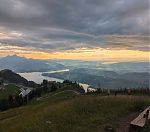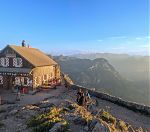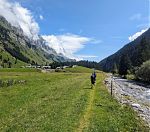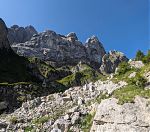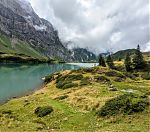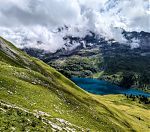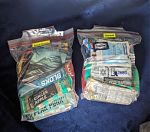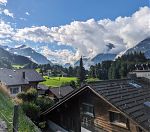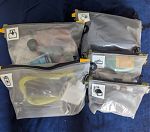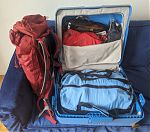26. August 2023
Swiss Peaks 360, Specific Period Reviewed
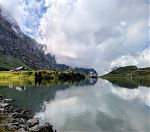 The specific period of training for this year’s edition of the Swiss Peaks 360 foot race is complete. Time to look back, taper, and fine-tune the preparation for the big adventure in the gorgeous mountains of Valais in Switzerland: over valleys and passes from Oberwald to Fiesch, Eisten, Grimentz, Grande Dixence, Finhaut, Morgins to Le Bouveret.
The specific period of training for this year’s edition of the Swiss Peaks 360 foot race is complete. Time to look back, taper, and fine-tune the preparation for the big adventure in the gorgeous mountains of Valais in Switzerland: over valleys and passes from Oberwald to Fiesch, Eisten, Grimentz, Grande Dixence, Finhaut, Morgins to Le Bouveret.
What I said would happen
The specific period of training is about practicing the aspects that are most specific for the race. In Swiss Peaks 360, Prepping for the Next Edition, I said it would “focus on race-specific training such as long day hikes, long uphill sessions with poles, night runs, more vertical, and volume”, and more recently in Swiss Peaks 360, Support Period Reviewed “long days out in the mountains with long uphill sections and long downhill sections; fine-tuning gear and logistics; (re)familiarizing myself with the route”. This training period covered July and August, including the tapering.
What actually happened
In the two months, I trained for ~86 h, of which 9 h went into pure hiking, 70 h went into a mix of running, trail running (which includes some hiking, too), and 7 h into strength training in the gym. I covered 523 km and 20 km of elevation gain. The ~ 3.8% average gradient in training during these two months did not match the ~ 7.5% average gradient in the event. I never did as much uphill in one month before (excl. last year’s Swiss Peaks 360) as in July. All in all, I am happy that I was able to put in as much as I did, and as much as I would have liked to, anyhow. In return, I got a lot out of the training as well. The specific training period is fun! After all, being in the mountains is specific training. I love being in the mountains.
The highlight at the beginning of July was the trail-maniacs 10 years anniversary event: a whole weekend spent to explore the valley behind Pilatus near Lucerne. Due to lucky circumstances, I was able to volunteer on Friday, helping to mark the trails with sawdust for the next day. I made a mistake in not packing enough sawdust. Serendipitously, we found a pile of sawdust on the side of the path, and we did not have to go out for a second time. Which left plenty of energy for the next day, going around various 5-12 km trails, sometimes twice. The trail-maniacs did an amazing job in organizing this weekend. Good fun, good training.
To Pilatus I returned once more, this time in order to get to the summit. I took the very first train in the morning in order to avoid the scorching heat to be expected later during the day. The contrasts were stark: once I got out of the tunnel hewn into the rockface near the top, I arrived on the platform conveniently reachable by the world’s steepest cogwheel railway. The smell of frying oil was just making its way from the kiosk powering up for the arrival of hungry tourists. I felt strangely out of place with my poles and trail running outfit. But it mattered little, the views onto Vierwaldstättersee were stunning.
Rigi is another well-known mountain. I found the opportunities to go up Rigi three times within two months. Well, once all the way from Goldau, and twice halfway from Seebodenalp for some magnificent after-work “sundowners” with the SSC and the trail-maniacs, respectively. I have a weak spot for watching sunsets, and in August, I went up Grosser Mythen with fellow trail runners (TrailRiderTV). I enjoy organising as much as taking part in events that other people put together. Very grateful for all of this.
On a long weekend around the Swiss National Day, I headed out with the Panorama Express to Meiringen. All the hikers on the train got out on the previous stop, and I was frankly a bit puzzled why they left me alone on the train. Until it dawned on me that the train was to descend into Meiringen, and that you’d have an easier start for various hikes if you left the train at a higher altitude. Anyhow, I wasn’t there to save myself from the uphill, and went up past beautiful waterfalls. A few minutes before arriving at a mountain restaurant called “Alpen Tower” (providing no view at the moment), where I intended to get a coffee and wait out some of the “scheduled” rain, I made the mistake of not putting on an extra layer (“will arrive soon anyways”). So, it took me much longer to warm up once I arrived there. Lesson learnt: layer up, layer down, timely. I moved on, with zero visibility, but moved on over a flowy trail. The clouds opened up, and I got views over Melchsee, Tannensee, Engstlensee and Trübsee before making my final descent to Engelberg.
Little did I know by then that I would be out and about agin the very next day with a couple of trail running buddies, exploring a beautiful panoramic trail near Klausenpass. This provided us with views into the cantons of Uri and Glarus. When taking a break, we even saw a part of the remaining glacier fall into a glacier lake; a few of the hikers got some wet feet and had to rescue their devices from the lakeshore as a result of the small wave. It reminded me of the shallow water equations (which I had heard of but cannot claim I understand), and it was fascinating to watch the turbulences.
Most importantly, unlike last year, I did not fall sick six weeks prior to the race, although managing the combined training stress and other life stressors has been challenging nevertheless. In any case, I had several weekends and days of good recovery.
What’s next
With one week of tapering done, and one more week of tapering to go, there’s nothing more that can be done or should be done in terms of training. Only getting rid of the accumulated fatigue in order to be ready for the big adventure.
The logistics need to receive the final touches. It’s time to pack all the gear for the race. After all, the Swiss Peaks is no walk in the park, but a 360 km journey with 25900 m of elevation gain over technical, not very runnable terrain. There are 32 checkpoints to the finish line, separated by a mean distance of 11 km, 809 m elevation gain, and 841 m elevation loss. The temperatures dropped after a heatwave. In the week prior to the race, the highest points of the race are recording minimum daily temperatures close to the freezing point. It makes only sense to pack accordingly.
The support from the volunteers in Swiss Peaks is outstanding. Still, between checkpoints and in checkpoints (that means: all the time), I need to look after myself, and I don’t have a support crew with me. In each lifebase, participants can get access to a 50 l bag. Last year, I had separate bags for different things: a bag with cereal bars, a bag with batteries, and so on. This year, I am pivoting to pre-packed bags for each stage: each bag containing supplementary fuel for in-between lifebases (~1050 kcal, 180 g carbohydrate, 11 g protein), batteries, disinfectant, a fresh headband, and so on. The idea is that I can thus easily restock supplies without having to rummage around in a bazillion bags, and having to consult the checklist whether I got everything. I expect that this will save me time and cognitive cycles.
This year, I am also adding “long-sleeved base layer hoodies” to my kit. I saw this from a fellow race participant from the US in 2022, who said that these were popular in the US. Such hoodies were difficult to find in Switzerland, but I finally managed to find a model that fit me. The idea is that these hoodies can protect me from the sun, and other elements. Less risk for sunburn around the neck and ears. I did not get sunburn last year, and I don’t plan to get sunburn this year either. Beyond sun protection, my mid layers also have hoodies. I tested that the hoodies are mutually compatible, so I can layer hoodies on top of each other. This will come in handy when the weather conditions change from sunny to cool, windy, and wet. I’m going to have an onion head.
In another attempt to keep what worked, and to tweak what can be improved, I replaced some of the flimsy (albeit very affordable) freezer bags by more solid zipper bags. I added huge labels to reduce the time and cognitive cycles it takes me to figure out what’s inside, when rummaging around in the 50 l bag. I got some packing bags with transparent windows for the same reason, to make the spare clothes more accessible. All for more efficiency in the pit stops.
Not too much changed in the carry-on gear compared to last year. I replaced the spare headlamp, saving 100 g and making it compatible with my primary headlamp. I dropped one of the two soft-flasks in favor of a larger hydration bladder. I added a zipper bag in order to stow away some of the fuel obtained at the checkpoints such that I can nibble on food between checkpoints, with the idea that this will put load on the GI system more evenly: otherwise, in addition to the fuel from the pre-packed bags, I would need to ingest thousands of calories at the 3-5 checkpoints alone.
I don’t have a good understanding of the cost of running/hiking. But according to this table on fellrnr.com, walking one mile (1.6 km) at a pace of 30 min/mile (18.6 min/km) on a 7.5% slope costs 150 kcal. Walking 360 km (224 miles) with an average incline of 7.5% will then cost a total of 224 * 150 kcal = 33600 kcal, or 4800 kcal for each of the seven stages on average. This in addition to a basal metabolic rate of maybe ~1800 kcal means I require ~6600 kcal per stage, and this estimate is likely at the lower end. It’s not possible for me to replenish such an enormous calories through food intake alone, but the body has fat reserves with enormous amounts of energy trapped. But the story is clear. There is a lot of calories to be burnt. There is a lot of calories to take in. To load the GI system more evenly, it’s better to eat less, more often.
Importantly, I will put on gaiters this time in order to reduce chances for dust, dirt, and stones making it into my shoes. Taking care of the feet is really important. Really, really important. As long as you can take another step, things are going fine. Thus, I also packed better in order to be able to take care of my feet in every lifebase.
Finally, it’s easy to think all about what should happen during the adventure and forget all about the before and after. This is all about bags in bags. I am taking a big trolley to swallow both the pre-packed 50 l bag, and my race kit, and an additional lightly packed backpack for stuff that I want to have before and after the race. On race day, I can empty the trolley without repacking any items, and put the backpack for the finish into the trolley instead. This makes sure I don’t have to carry much on my back before and after the race. Efficient, like in a pit stop.
Gear aside, this is a big challenge where I will need to be in the right headspace. This will take a lot of grit. This will take hundreds of small, good decisions. This will require the most important skill of all, which I fortunately practiced many times over. Get out of the door. Get moving. Everything else follows. Only one week to go. I’m excited.
